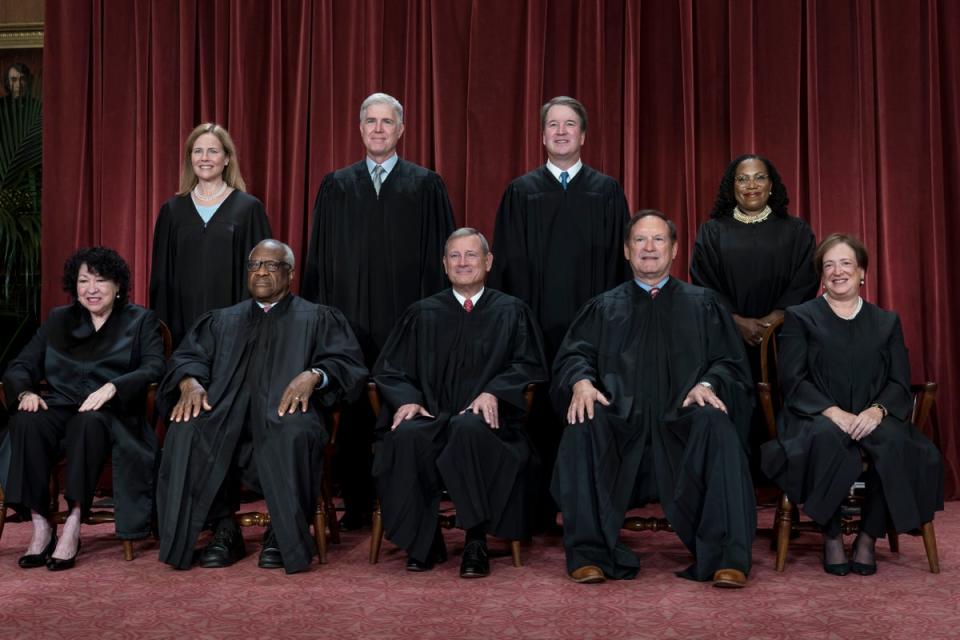As Biden proposes overhaul of Supreme Court, how did we get here?

For years, a storm has been brewing at the Supreme Court.
Unpopular rulings led by the court’s conservative majority, overturning decades-old legal precedents, and allegations of ethical misconduct has seen approval ratings for the court plummet among Americans.
As the court has ruled to remove federal protections for abortion, effectively overturned affirmative action and more, increasing numbers of people have demand greater transparency from the nine justices.
In an effort to rein in the court, lawmakers have suggested legislation, and even threatened impeachment, to hold the justices accountable.
Now, President Joe Biden is set to propose a major overhaul including term limits for justices and an enforceable code of ethics on the institution.
The back story
The Supreme Court was formed as part of the Constitution in 1787. But the Constitution did not explicitly give the court the power it is known to have today to review legislation, or actions taken by the president.
The Constitution did establish several “checks”, however. The president nominates judges to the bench but they must be approved by Congress.

Congress also has the power to pass legislation that limits or changes the court’s structure and rulings. But that hasn’t happened in a long time, even after multiple scandals.
Last year, ProPublica investigations revealed that conservative Justice Clarence Thomas has accepted hundreds of thousands of dollars worth of luxury vacations, private travel and tuition for his great-nephew from Republican megadonor Harlan Crow for more than two decades– and never disclosed it.
Conservative Justice Samuel Alito took a luxury vacation with a Republican donor who had business interest in a case before the court but did not disclose it. Nor did he recuse himself from the case.

A closer inspection of the nine justices’ finances revealed myriad ways that they benefited from their positions but have not disclosed. Justice Sotomayor earned millions from book sales, in part thanks to her staff encouraging schools that she spoke at over the years to purchase them.
In May, the New York Times revealed that Justice Alito’s wife hung an upside-down flag - a symbol used by January 6 rioters - at their Virginia home. The incident took place while Justice Alito was deciding a case that directly affected the sentencing of some rioters.
What is Biden proposing - and why now?
Biden is reportedly planning on endorsing legislative proposals that would alter the structure of the court by enacting term limits and enforcing a code of ethics.
He told a group of lawmakers in the Congressional Progressive Caucus on Saturday that he has spent the last three months working with constitutional scholars on the initiative, according to The Washington Post.
Both proposals would require congressional approval, a massive hurdle in the Republican-controlled House, where GOP lawmakers have largely supported the court’s decisions.
Biden’s proposal is likely linked to the court’s low approval ratings and recent rulings that Democrats worry could embolden Donald Trump should he be re-elected in November.

Earlier this month, the Supreme Court ruled in favor of giving the president absolute immunity over “core powers” and sweeping immunity over “official acts” in office.
But Biden’s plan also serves as leverage when trying to convince potential supporters to vote for him. The conservative majority of the court is made up of three Trump appointees and if the former president is re-elected, justices could step down which would allow Trump to tap other conservative judges.
“Just imagine if he has two more appointments, what that means,” Biden said in an interview with BET on Tuesday.
Has anyone tried to change the Supreme Court before?
At various points in history, lawmakers have proposed changes to the court - but none have come to fruition.
The closest moment was when president Franklin Delano Roosevelt (FDR) introduced legislation to “pack the court” or add more seats to the court in 1937. The plan was to pass a law that would allow the president to appoint a new justice for every current justice over 70. But in the end, it failed before the Senate.
Pushes for reform over the last year have met a similar fate. Dick Durbin, chairman of the Senate Judiciary Committee, tried to fast-track a bill to improve transparency and enact an enforceable code of ethics last year but Republicans have kept it tied up at the committee stage.
Democrat Alexandria Ocasio-Cortez introduced articles of impeachment in the House against Justices Thomas and Alito for refusing to recuse themselves from cases with potential conflicts of interest. But in a Republican-controlled House, it is unlikely the move will receive the majority vote.
What is the likely outcome?
Biden and other lawmakers’ efforts to reform the Supreme Court is an uphill battle.
Any legislative action, like the kind Biden is endorsing, would require the support of Republicans in the House and Senate, who are unlikely to back these changes to the court given the majority currently swings in conservatives’ favor.